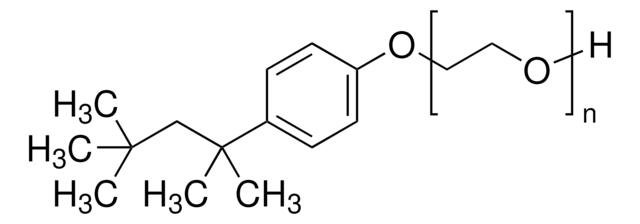X405
Triton™ X-405 solution
70% in H2O
Synonym(s):
4-(1,1,3,3-Tetramethylbutyl)phenyl-polyethylene glycol solution, Polyethylene glycol tert-octylphenyl ether, Polyoxyethylene (40) isooctylphenyl ether
About This Item
Recommended Products
description
non-ionic
Quality Level
mol wt
~1967.0 g/mol
concentration
70% in H2O
technique(s)
ELISA: suitable
CMC
0.81 mM
transition temp
cloud point >100 °C
density
1.096 g/mL at 25 °C
HLB
17.6
SMILES string
CC(C)(C)CC(C)(C)c1ccc(OCCOCCOCCOCCOCCOCCOCCO)cc1
InChI
1S/C28H50O8/c1-27(2,3)24-28(4,5)25-6-8-26(9-7-25)36-23-22-35-21-20-34-19-18-33-17-16-32-15-14-31-13-12-30-11-10-29/h6-9,29H,10-24H2,1-5H3
InChI key
HNLXNOZHXNSSPN-UHFFFAOYSA-N
Looking for similar products? Visit Product Comparison Guide
General description
Application
- to re-disperse semiconducting single-walled carbon nanotubes (S-SWCNTs/SWCNTs) for absorption spectroscopic characterization
- as a component of sodium hydroxide solution to solubilize animal carcasses for liquid scintillation counting
- as a surfactant in direct foaming to study its effects on the viscosity of geopolymer pastes
Caution
Legal Information
signalword
Danger
Hazard Classifications
Acute Tox. 4 Oral - Aquatic Acute 1 - Aquatic Chronic 1 - Eye Dam. 1 - Skin Irrit. 2
Storage Class
10 - Combustible liquids
wgk_germany
WGK 3
flash_point_f
Not applicable
flash_point_c
Not applicable
Choose from one of the most recent versions:
Certificates of Analysis (COA)
Sorry, we don't have COAs for this product available online at this time.
If you need assistance, please contact Customer Support.
Already Own This Product?
Find documentation for the products that you have recently purchased in the Document Library.
Our team of scientists has experience in all areas of research including Life Science, Material Science, Chemical Synthesis, Chromatography, Analytical and many others.
Contact Technical Service





